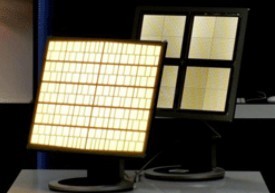For general lighting, OLEDs have to compete with existing and upcoming lighting, achieving power efficacies of up to 100 lumens per watt, which fluorescent tubes are capable of, and operational lifetimes of up to 100,000 hours, which are now possible with commercial inorganic LED lighting. As well as improving efficacies and long operational lifetimes equivalent to commercial general lighting technologies, the project has also focused on fabrication on larger glass substrates.
As part of the dissemination of the project next month a press event will be held where a demonstrator based on nine 33cm x 33cm panels connected together will be unveiled. OLED100 was completed at the end of August.
OLED100 coordinator Stefan Grabowski works at Philips in Aachen, Germany, where the company's OLED lighting pilot facility is also located. Grabowski presented an overview of the project's final results earlier this week at the Plastic Electronics 2011 conference and exhibition in Dresden.













